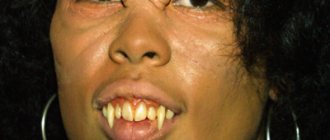Hydrophobia or aquaphobia is a phobia associated with the fear of water. People susceptible to it are afraid not only to swim, but also to approach the water, look at it, wash themselves and sometimes even drink the water. In some cases, pathological fear can be caused not only by water itself, but also by various liquids and drinks.
Fear of water gives a person severe discomfort both mentally and physiologically, and greatly reduces the quality of his life, because he has to deal with water literally every day. A hydrophobe is forced to give up many of the joys of life, for example, relaxing at sea or traveling along it, visiting swimming pools and saunas, and can even limit to the maximum the frequency of taking necessary hygiene procedures in order to have contact with water as little as possible. Professional treatment for hydrophobia can help a person get rid of it, return to normal life again and use water at any time without problems.
What is hydrophobia
Hydrophobia (aquaphobia) is the fear of water. It occurs 3–4 times more often among children than among adults. For most people, aquaphobia manifests itself as a fear of swimming. However, depending on the causes and stage of development of the phobia, people may be frightened by the sight of a river or a trickle of water, the sound of rain, or the feeling of drops on their body. For some, even taking a shower, washing your face and washing your hands becomes an alarming event. And some are even afraid to take a glass of water.
It is important! Most often, aquaphobes experience fear of swimming. They feel like the water is suffocating them. A person is afraid of choking or drowning, or getting entangled in algae.
What is fear of water
When answering the question of what the fear of water is called, experts use the word hydrophobia. In other words, the term aquaphobia can be applied to such fear. A person with such fear avoids open water spaces; he does not want to swim. This phobia creates many inconveniences in life. For example, people with a phobia of water cannot visit swimming pools or saunas. For some, difficulties arise in everyday life. Taking a shower turns into an ordeal.
Fear of water has a special terminology in psychology. Such definitions are necessary to identify a specific fear. Next, we’ll figure out what each phobia is called and what it means.
Ablutophobia means fear of contact with water. Bathophobia indicates that a person is afraid of the deep bottom. Fear of water can also manifest itself as limnophobia (large volume of liquid). The definition of thalassophobia is usually applied to people who have a fear of the sea. There is also anthlophobia, omnophobia and chionophobia. Individuals may be afraid of flooding, flooding, exposure to rain and snow.
Symptoms and types of hydrophobia
Each of the named fear varieties of hydrophobia has its own name:
- dipsophobia – fear of drinking water;
- bathophobia – fear of deep bodies of water;
- Ablutophobia – fear of hygiene procedures in the bathroom;
- potamophobia – fear of fast currents, whirlpools;
- Thalassophobia – phobia of the sea;
- limnophobia – fear of lakes;
- anthlophobia – fear of floods;
- chionophobia – fear of snow;
- Ombrophobia – fear of getting caught in the rain.
All varieties have similar psychophysiological symptoms.
On a psychological level
The main indicator is fear of water in any of its manifestations. How else does aquaphobia manifest itself on a psychological level:
- increased anxiety when drinking, entering water, approaching water, or at the thought of contact with water (depending on the stage);
- delaying hygiene procedures;
- reluctance to wash and bathe;
- increased excitability, nervousness on the beach and in other places near water;
- making up excuses to avoid going swimming or getting caught in the rain;
- panic when drops of rain or snow hit the skin;
- obsessive negative thoughts about possible tragedies.
A person tends to fantasize and come up with unfavorable scenarios for the development of events.
On the physical level
Physical signs are nonspecific:
- tachycardia;
- hyperhidrosis;
- breathing problems;
- hypertension;
- feeling of dry mouth;
- convulsions;
- clouding of consciousness;
- dyspnea;
- tinnitus;
- tremor of the limbs;
- frequent urination;
- muscle aches;
- icing of extremities;
- dizziness;
- disorientation.
How to recognize a phobia
The fear of water does not always have a mental cause. There are often accidents that result in people drowning. Then, on a physical level, the body remembers the situation and all the visual and tactile objects associated with it.
Unlike rabies, hydrophobia does not have symptoms such as delusions, photophobia and hallucinations. A phobia of water is not fatal. It's just a mental disorder. It’s better not to joke with rabies; if you have the first signs of it, you should definitely consult a doctor.
Aquaphobia includes psychological and vegetative symptoms.
At the mental level, the following symptoms exist:
- a person does not like it when water comes into contact with his skin;
- he is afraid of depth and open waters;
- the individual panicky does not want to swim or bathe.
Also, if there is snow or a thunderstorm outside, the phobia of water manifests itself in the form of a fear of leaving the room. The rarest cases include anxiety regarding the use of liquids inside the body.
At the physical level, water phobia manifests itself as follows:
- a person feels sick;
- dizzy;
- constant headache;
- pressure rises.
Please note that fear of water can cause profuse sweating.
If left untreated, an aquaphobe may experience panic attacks if they go far into the water. Seizures and other somatic symptoms often occur. A person’s consciousness tends to turn off in such situations; he no longer controls his thoughts and actions. At this moment, life may be at risk. It is important to overcome your phobia of water at the earliest stages.
Main causes of phobia
All varieties have common psychological and somatic prerequisites.
The most common stressful situations are:
On average, fear of water develops at 3–5 years of age and persists thereafter. That is, adult fears, as a rule, come from childhood. In turn, in childhood, fear of water may appear for the following reasons:
- injuries in the form of attempted drowning of a child or someone’s death before his eyes;
- extreme methods of teaching swimming that frightened the child or caused physical injury;
- punishment with water, child abuse;
- personal negative experience with water (frostbite, burns, fear, pain, unpleasant tingling of the eyes, etc.);
- convulsions that occurred while the child was in the water;
- parents misunderstanding the child’s fears and forcibly pushing him into the water;
- improper bathing of the child (hot or cold water, sudden immersion in the bath);
- improper child care (wet diapers).
Childhood psychotrauma may be indirectly related to water. For example, one of the parents died when it was raining outside. Or mom and dad had a big fight while the family was on the beach. Or an angry parent splashed cold water on a child. And so on.
In adulthood, aquaphobia can develop after violence near or using water, after the death of a loved one in the water, after a seizure or other unpleasant situation that happened in the water. And also if a person had to survive a natural disaster.
Both in childhood and among adults, impressionable people are at risk. Such a person may develop a phobia, fear of water, after watching a film about a water disaster or after watching horror and thrillers with scenes of violence. Or after news of someone drowning, shark attack, etc.
This is interesting! Among the physical prerequisites for hydrophobia are rabies and tetanus, fetal hypoxia during pregnancy, and throat diseases that interfere with drinking water. When contracting rabies, hydrophobia (fear of water) is one of the symptoms.
The most common occurrence: surviving an accident
No one is insured against an accident. And even if everything ends well, the memory of what happened will haunt the person for the rest of his life.
Examples of situations and accidents:
- drowning while swimming;
- shipwreck;
- choking on water while eating;
- natural disasters (storm, snow drift);
- thunderstorm (scares children, fear transfers to any situation involving water);
- a person does not feel the bottom while swimming.
The risk of developing a phobia increases if an accident occurred in childhood. Sometimes a fear of water at this age can develop against the background of a fictitious accident. Children under 6 years of age are prone to fantasizing, and they themselves can be frightened by their own made-up stories.
Rabies is dangerous!
1. Definition. Brief historical information about the disease
.
Rabies is an acute infectious disease of animals and humans caused by a virus that affects the central nervous system and is always fatal. Synonyms: hydrophobia, lat. -rabies, hydrophobia.
Rabies was known to people long before our era and is described in various ancient books. Already in Egyptian papyri, Indian sacred books Vedas, Greek and Roman sources, and then in the Bible, rabies was told about rabies, which is transmitted to people from enraged animals (wild and domestic). The dangers of this disease were written about in the Middle Ages, the Renaissance and later. The first mentions of human disease with hydrophobia in Belarus date back to the beginning of the 19th century, although it is known from ancient chronicles that cases of human rabies were noted earlier on the territory of the republic. Officially, the first case of hydrophobia in a person in the republic was registered in 1923.
Currently, rabies is widespread throughout the world. The only exceptions are Antarctica and the island states of Oceania. In the territory of the Republic of Belarus in recent years there has been a significant increase in the number of animals with rabies.
2. Who can get rabies?
Rabies affects almost all species of terrestrial mammals, primarily carnivores (families canines, felines, mustelids, raccoons, etc.). Wild and domestic birds, rodents, and bats can also get sick. Every year in our country hundreds of cases of the disease are recorded among wild (foxes, raccoon dogs, wolves, etc.) and domestic (dogs, cats, cattle, horses) animals. There have been isolated cases of hydrophobia with fatal outcomes among people.
The source of rabies is a wild animal that became infected in the natural environment, as well as a domestic animal that was attacked by another sick animal (wild or domestic). Humans become infected from sick animals.
3. How does infection occur?
The causative agent of rabies is a specific virus contained in the saliva of a sick animal.
Human infection occurs through a bite and penetration of saliva from a sick animal into the wound. Having penetrated through damaged skin, the rabies virus spreads along the nerve trunks to the brain and spinal cord. This is where the virus multiplies and accumulates mainly. Then it penetrates the salivary glands and is released with saliva into the external environment. The virus appears in saliva 1-7 days before the first clinical signs of the disease. Therefore, you can become infected with rabies through a bite inflicted by an apparently healthy animal. Infection can also occur if saliva gets on the mucous membranes of the eyes, nose, mouth, or damaged skin. Scratches caused by claws are very dangerous: animals often lick their paws, so a sufficient amount of virus remains on the claws for infection. You can also become infected when cutting up the carcass of a sick animal, as this often results in cuts to the fingers. Unusual routes of infection should be mentioned. In recent years, the literature has described isolated cases of human infection through intact skin, by airborne droplets (in laboratory conditions, in a cave with millions of bats), through the placenta during pregnancy, and during organ and tissue transplantation. Cases of infection through the digestive tract have been described, so far only for animals. As for humans, to date there is not a single case of human illness known after consuming meat or milk of sick animals.
This is due to the fact that the rabies virus rarely penetrates the blood and glandular organs.
In addition, the virus is unstable in the external environment; it dies under normal pasteurization regimes, and when boiled, it dies instantly. The most dangerous bites are those caused by rabid wolves, foxes, raccoon dogs and
other wild carnivores and bats. Dog and cat bites are somewhat less dangerous. Cases of human infection after contact with a sick farm animal (cow, horse, goat, sheep, pig) are rare. Poultry, although they can get rabies, are not capable of infecting humans due to the lack of salivary glands. Unlike domestic birds, birds of prey (for example, falcons) can infect humans. However, these birds are very rare in the natural environment and the likelihood of their contact with humans is negligible. The possibility of infection of a person as a result of a bite inflicted by a rodent: rabbit, hare, squirrel, muskrat, rat, hamster, mouse cannot be ruled out. However, no reliable cases of human infection from these animals have been described in the world literature.
4. What damage is considered the most dangerous?
The period from the bite to the onset of the disease (latent or incubation period) averages 30-50 days in humans, although it can last 10-90 days, in rare cases - more than 1 year. Moreover, the further the bite site is from the head, the longer the incubation period. Consequently, taking into account the localization (location) of the damage, bites to the head, face and neck are especially dangerous. The category of severe (dangerous) injuries also includes bites on the fingers, because these parts of the body have many nerve endings. Bites to the forearm, shoulder, and torso are considered less dangerous. The incubation period lasts the longest for a bite on the legs.
6. What should you do if you are bitten by an animal?
The duration of the incubation period (i.e., the period preceding the onset of symptoms of the disease) in animals ranges from a week to several months (sometimes years), but already 5-10 days before the onset of the disease the animal is infectious. A characteristic sign of an animal disease in the first stage should be considered a change in behavior: an angry animal becomes affectionate, unreasonably animated, tries to lick the owner’s face; good - angry, irritable, does not respond to the owner’s call, hides in dark corners. The animal refuses its favorite food, but swallows inedible objects (wood, stones, etc.), and sometimes there is increased sensitivity to light and noise. Body temperature rises slightly. If we talk about wild animals, then for those who are sick, such a change will be the desire to make contact with a person: a healthy wild animal will never voluntarily go to a person and will run away whenever they try to get closer. The initial stage of the disease is replaced by the second stage - the stage of excitation, in which the animal’s irritability increases and aggressiveness occurs. An animal can attack or bite for no apparent reason. Next comes the third, paralytic stage, very characteristic of the appearance of the animal: the fur is tousled, the lower jaw droops, the tongue falls out, saliva flows from the mouth. On the 8-10th day the animal dies.
When talking about the clinical manifestations of rabies in animals, one should dwell in detail on the behavior of sick dogs and cats, because
most often encounter these animals .
Rabies in a dog.
In the initial period, the dog becomes depressed, responds reluctantly to calls, and lies down more.
The appetite is sluggish, indifferent to water (but, as a rule, there is no hydrophobia). It must be emphasized that hydrophobia (fear of water) is not a characteristic sign of rabies in dogs. This is very important, since some people, seeing that a dog is not afraid of water (drinks water, swims across a river, etc.) consider it healthy and, if bitten, scratched or salivated by such a dog, do not take protective measures or seek medical help .
By the end of the 2nd day of illness, anxiety and irritability often appear; the sick dog tries to go to some distant corner (under the porch, bed, etc.). Signs of clouding of consciousness occur, she barks for no reason, her voice becomes hoarse, dull, gasps for air and makes other involuntary movements, which never happens normally. Sometimes, as a result of itching at the site where she was bitten by a rabid animal, she chews on the healed wound. It is typical for the dog to swallow inedible objects: chips, stones, etc. As a result of growing excitement, the dog runs away from home, running up to 50 km a day. Along the way, she silently attacks people and animals. The period of excitement lasts 3-4 days, after which attacks of convulsions and paralysis occur. Dogs die on days 6-8 of illness. It should be remembered that the described picture of rabies in dogs is not always observed. But in any case, the animal’s normal behavior changes dramatically, which should alarm the owners and be the reason for inviting a veterinarian. Attempts to treat a dog that allegedly choked on a bone often resulted in rabies.
Rabies in a cat.
Rabies is more severe in cats than in dogs. The first signs of the disease come suddenly and are expressed by increasing anxiety and agitation. The meowing becomes hoarse, dull, the look (very characteristic!) is frightened, cautious. The cat refuses food and avoids its owners. The next day, the cat becomes aggressive, with particular anger it attacks dogs and humans. Excitation lasts 1-2 days, and then paralysis develops. Death occurs within 2-5 days. A characteristic feature of bites from a sick cat is a spasm of the masticatory muscles, as a result of which, after a bite, such a cat can be extremely difficult to tear away from the wound.
It should be emphasized that in case of any illness in the animal, and especially when symptoms of rabies appear, you should immediately contact the nearest
veterinary station. Under no circumstances should you self-medicate an animal - this is deadly!
6. What should you do if you are bitten by an animal?
It is very important to teach the child (his parents) to properly provide first aid to himself and others in case of a bite.
If a child or adult is bitten, scratched, slobbered by any animal, even an apparently healthy one, much less a neglected or wild one, or if there is a suspicion that it has rabies, you should immediately:
1) intensively wash the wound with soap and water for 10-15 minutes, which will wash away the animal’s saliva. It is recommended to wash deep wounds with a stream of soapy water, for example, using a syringe. There is no need to cauterize wounds.
2) apply a sterile bandage to the wound.
You should be warned about the danger of sucking the wound with your mouth.
After this, you must contact the nearest trauma center or any medical institution (clinic, hospital, medical center) as soon as possible. If possible, it is necessary to collect as much data as possible about the bitten animal (description of the animal, its appearance and behavior, presence of a collar, circumstances of the bite, etc.). If the animal is domestic (dog or cat) and has been vaccinated against rabies, then you must take with you a veterinary certificate confirming the vaccination or a registration certificate with a mark on the vaccination.
7.
What will you do with an animal that has bitten you?
It is very important to indicate that simultaneously with contacting a doctor about a bite, it is necessary to take measures regarding the bitten animal (it must be tied up, isolated) and call a veterinarian for consultation. Appearingly healthy pets (dogs or cats) are subject to veterinary supervision for 10 days from the date of the bite. A sick animal must be euthanized. It is impossible to save him. As the disease progresses, the behavior of such an animal is uncontrollable. It is important to prevent human infection.
8. What measures do you know to prevent rabies in animals?
Should a person, caring for the safety of his life, refuse to communicate with animals? Not a single mechanical toy can replace human communication with a living creature of another species. They give us their love and affection, heal us, make us kinder and more humane. We must always remember that animals need care and supervision; they, like people, are susceptible to many diseases. In order to prevent rabies in domestic animals, the Rules for keeping them should be followed:
within three days, register the purchased animal and report it to the veterinary station;
It is mandatory to vaccinate your pet (over 3 months old) against rabies every year; it is better to do this in the winter and spring, especially before going outdoors;
walk animals in specially equipped areas or vacant lots, take dogs outside on leashes and muzzles (this will protect the animal from possible contact with sick wild or stray animals and eliminate the possibility of your animal biting anyone);
You cannot bring dogs and cats to shops, catering and consumer services establishments, schools and preschool institutions, public buildings, parks, squares, stadiums, markets;
minors are prohibited from walking dogs of potentially dangerous breeds;
Under no circumstances should you leave or abandon your animals unattended on the streets, squares, markets, entrances and other places, including in the country.
The best way to prevent rabies in wild animals is to vaccinate them by placing baits containing the vaccine near their natural habitats.
9. Are there any treatments for rabies?
TO
Unfortunately, to date, a person with rabies cannot be cured. Treatment is reduced to alleviating the general condition of the patient. In this regard, the prevention of rabies becomes extremely important in the fight against this disease. It includes the fight against sources of infection (animals with rabies) and the prevention of the disease in humans.
10. What preventive measures are there if you are bitten by an animal?
All kinds of recommendations for the prevention and treatment of rabies - the destruction of enraged animals, cauterization of bitten areas in people with a hot iron - did not produce any effect. Almost every person bitten by a rabid animal was doomed to death. Until the 80s of the 19th century, people did not have a reliable means of protection against this terrible disease.
The great French scientist Louis Pasteur has the honor of creating a vaccine against rabies, which was successfully used for the first time on July 6, 1885. Then, thanks to vaccination, a boy bitten by a rabid dog was saved. And some time later, in a French village, children playing were attacked by a rabid dog. Defending them, fifteen-year-old shepherd Jean Jupille accomplished a real feat. He managed to tie the dog's face with a belt whip and kill it with his wooden shoe. But the boy's entire body was covered with wounds. Barely alive, Jean was brought to Paris. Pasteur saved the hero.
To this day, vaccinations remain the only reliable means of protecting people after being bitten by an animal sick or suspected of having rabies. These include the administration of a vaccine and, if necessary, immunoglobulin.
What you need to know about preventive vaccinations:
-if the doctor prescribed vaccinations, they should be started immediately;
- you should never skip the next vaccination;
-the course of vaccinations prescribed by the doctor must be completed in full;
-a person who is vaccinated is not dangerous to anyone;
- during vaccinations, you should not drink alcoholic beverages for 6 months after their completion; you should avoid overwork, hypothermia, and overheating.
Along with vaccinations, on the recommendation of Belarusian scientists, antibiotic prophylaxis is also carried out.
11. How to avoid being bitten or salivated by unknown animals?
Children are more likely to suffer from animal bites, so it is necessary to constantly educate them and try to avoid unnecessary contact with animals, especially wild and/or stray ones:
You should not play with unfamiliar dogs, cats and other animals; it is better to stay at a safe distance from them;
should not be picked up at the dacha, in the forest, etc. wild animals. Hedgehogs and small rodents can also carry rabies. Incorrect or inappropriate behavior of a child who, due to his age, will not be able to correctly assess the situation, can lead to aggression in any animal, especially a sick animal;
It is better not to pick up homeless stray or sick animals, but if you do, then find an opportunity to quickly vaccinate the animal and show it to a veterinarian;
You should not take an animal “for the summer holiday season”: by throwing it away, you increase the risk of rabies in the given region. It is better not to send children under 12-14 years of age to walk a dog on their own, especially if it is a large and/or aggressive breed of animal. The child may not be able to cope with it, and in the event of a non-standard situation, he may not be able to adequately explain the essence of what happened.
REMEMBER
are very dangerous .
The saliva of wolves, foxes, and raccoons is permeable and contains a large amount of virus.
But you also need to be careful with your pets.
A dog is a good friend and helper of a person, but 85% of people who sought medical help for bites suffered precisely because of improper keeping of domestic
Homeless, stray and unsupervised dogs are especially dangerous. Proper keeping of pets is one of the most important conditions for preventing rabies infection.
If you notice any changes in the animal's behavior,
Take him to your veterinarian immediately.
Rabies is a relatively rare disease, and medicine does not have the means to treat it. However, highly effective vaccines
protecting people from this disease. Therefore, after an animal bite, you should wash the injury site with soap and water, treat it with iodine tincture and consult a doctor.
Only a doctor can determine the need for vaccination. Unauthorized interruptions in vaccination, termination and reduction of the course of vaccinations prescribed by a doctor are unacceptable, because In such cases, the development of immunity is delayed and there is a risk of disease. During
vaccination, it is strictly forbidden
to drink alcoholic beverages, because alcohol reduces the body's overall resistance and often causes unsuccessful vaccinations. You should follow a normal sleep and rest schedule, spend more time in the fresh air, and it is not recommended to overwork or overcool.
Need to know
that the saliva of animals becomes infectious 10 days before the onset of the disease. Therefore, if a person is bitten by an animal, under no circumstances should he be killed within the next 10 days, i.e. the period required for veterinary observation.
If during this time the animal remains healthy, vaccinations against rabies are not carried out.
- If you are bitten by any animal, immediately contact the nearest medical facility.
- Avoid unnecessary contact with wild and stray pets.
- Timely vaccinations will protect you from rabies.
- Animals are vaccinated against rabies in all veterinary institutions free of charge.
The material was prepared by the head of the department of hygienic education I.V. Varada.
| print version | Version for MS Word |
Features of hydrophobia in adults and children
Treatment of adults and children is not much different. In both cases, it is necessary to determine the cause of fear and teach the person techniques for coping with stress. Only the methods of psychotherapy differ.
Freeing children from phobias
How to help your child at home:
- in the form of a game and in a pleasant psychological environment, bring the aquaphobe to water;
- create a favorable psychological atmosphere in the house (all children's fears appear due to general tension and anxiety);
- show by the example of other children and adults what joy swimming and relaxing in a water park brings;
- arrange a bath with oils and aromatic candles.
You can get rid of fear through indirect contact with water, for example, come up with a fairy tale in which a child overcomes his fear or saves someone from the water. Art therapy is effective in childhood. You can visualize the fear of water and play a scene or depict in a drawing how a child overcomes his fear.
What is prohibited to do:
- force a child to go into the water;
- forcibly bathe a child, drag him into water;
- shout and punish.
It is important! Most childhood fears go away on their own over time. If a child cannot overcome his fear of water, then it is necessary to consult a psychologist.
Helping adults overcome their fear of water
To get rid of hydrophobia yourself, follow the following plan:
- Try to determine what situation started the phobia.
- Analyze this case. Think about how much of your responsibility is in what happened. What can you do now to prevent this from happening again? If this happened through no fault of yours, then you need to accept the fact that you cannot control everything.
- Make a list of scary situations. Write down each of them in detail: what exactly scares you and why.
- Master self-regulation techniques: auto-training, meditation, relaxation, breathing exercises.
- Start getting closer to the object of fear. First achieve a relaxed state, and then approach the object of fear. You can start with a photo or video of water. Then move on to real life: a walk along the river bank, a trip to the pool.
If you are afraid of drowning because you don’t know how to swim, then no matter how paradoxical it may sound, you need to learn how to do it. These days there are a lot of programs for both children and adults. You can hire a personal trainer.
It is important! You can only overcome your fear of water by facing your fear face to face. Shock therapy (an abrupt meeting) is suitable for some, while gradual rapprochement combined with relaxation is suitable for others.
Treatment of children
Hydrophobia is one of the most common fears among children. It is important that parents make the maximum amount of effort to work with such a phobia, since fear subsequently accompanies the person for the rest of his life.
In the first stages, parents should find out the reasons that cause a phobia of water. If necessary, you can seek help from psychotherapists.
The first fears appear when the baby is immersed in water with a low temperature. In such situations, you need to combine bathing the child with play elements. For example, you can play with soap bubbles or use water toys. This way, water will become normal for the child. It is also practiced to have special rules that the baby himself decides how exactly he will bathe and what objects he will use. A phobia of water with such actions on the part of adults simply cannot develop in childhood. So the child himself controls his relationship with the water space, and accordingly there is no room for the emergence of fears.
To overcome hydrophobia, there is a method of telling a child about heroes who were not afraid of water and did heroic deeds. The child should feel like a character who saves other people and prevents them from drowning.
In some cases, children refuse to swim naked. At the same time, they feel panicky fear. It is important to give the child the opportunity to plunge into the water with clothes on; you need to have patience. As you grow older, your fears go away. It is possible that over time the child will simply forget that such fear exists in his life. There is no need to focus on the fact that a phobia of water interferes with a person’s life. This causes him to replay unpleasant memories in his head over and over again.
If your child does not agree to take baths, it is important to be patient. Under no circumstances should you raise your voice at children, as this creates even more stressful situations and strengthens fears. Such a child withdraws into himself; he does not hear the arguments of adults. Communication problems may arise in the future.
What is the help of specialists in control and prevention?
Depending on the severity of the phobia, treatment may consist of psychotherapy or treatment is provided using psychotherapy methods and medication. If the phobia of water is complicated by panic attacks, then antidepressants, tranquilizers, and sedatives are prescribed. If medication is not needed, then only psychotherapy is selected. Hypnosis, NLP, and cognitive behavioral psychotherapy are commonly used. The average course of psychotherapy is 2 months.
Psychotherapy sessions can be individual or group. The purpose of the classes is to eliminate the causes of the phobia. The specialist penetrates the client’s subconscious and reveals the deep causes of fear. Next, work is carried out to change the attitude towards past experience and correct perception, teaching the client relaxation methods.
Additionally, work is carried out to correct a person’s self-perception and character. It is necessary to increase self-confidence, to rid the client of suspiciousness and anxiety, and excessive impressionability.
It is important! Only a psychotherapist can determine the course of treatment and, if necessary, prescribe medications. Only a specialist can accurately determine the cause and living conditions, personality traits that are prerequisites for the development of a phobia.
What is aquaphobia?
The term "aquaphobia" describes a type of anxiety disorder that involves an intense fear or aversion to water. The World Health Organization (WHO) estimates that in 2015, 264 million people worldwide had at least one anxiety disorder. Anxiety disorders include a group of conditions associated with feelings of fear and anxiety. Specific phobias, including aquaphobia, are a type of anxiety disorder.
As with other anxiety disorders, the severity of aquaphobia varies. Some people may be afraid of deep bodies of water or fast-moving rivers, while others may be afraid of any body of water, including swimming pools, hot tubs, and regular bathtubs.
Let's learn not to be afraid in the pool
After completing the first four steps to overcome your phobia, you can sign up for water aerobics or swimming in our pool. We have an experienced trainer with about 20 years of experience in water aerobics. For those who sign up for individual training, a specialist will develop a personal set of exercises that will first help overcome fear, and then completely comprehend the art of swimming. We conduct sessions for both adults and young clients, for whom we organize play-based activities, which greatly helps them relax and overcome panic.
Aquaphobia - reasons
The cause of aquaphobia and other specific phobias remains unknown. However, one theory suggests that phobias develop when a person experiences an emotional event or reaction while under the influence of an object or situation that causes fear or anxiety.
For example, a person may swim in the ocean or public pool and become injured or witness a person drown. As a result of this exposure, a person may constantly associate water with danger.
Another theory suggests that phobias are learned associations. For example, a person may develop a particular phobia after observing a phobic reaction in another person, such as a parent, sibling, or friend. A person may internalize another person's fear response and adopt a similar aversion to an object or situation.
Symptoms of animal phobia, injection or injury phobia, and natural habitat phobias—including aquaphobia—usually begin in childhood.
How to overcome hydrophobia for adults
Typically, adults begin to suffer from aquaphobia due to unpleasant incidents while swimming that lead to stress. Moreover, it is much more difficult for them to cope with their phobia than in childhood, because little people are afraid of discomfort, not death, their self-preservation instinct is not yet so developed.
To stop being afraid of water, you need to:
- remember exactly what incident caused panic and abandonment of reservoirs;
- returning to terrible memories, teach yourself to calm down;
- write down for yourself all the phobias that prevent you from starting to learn to swim;
- re-read the compiled list every day and it is advisable to experience one terrible situation, trying to cast aside all fears about what happened;
- Going for walks to bodies of water more often, signing up for a swimming pool or going to a water park, watching others have fun - this will help you want to try for yourself what everyone likes so much.









